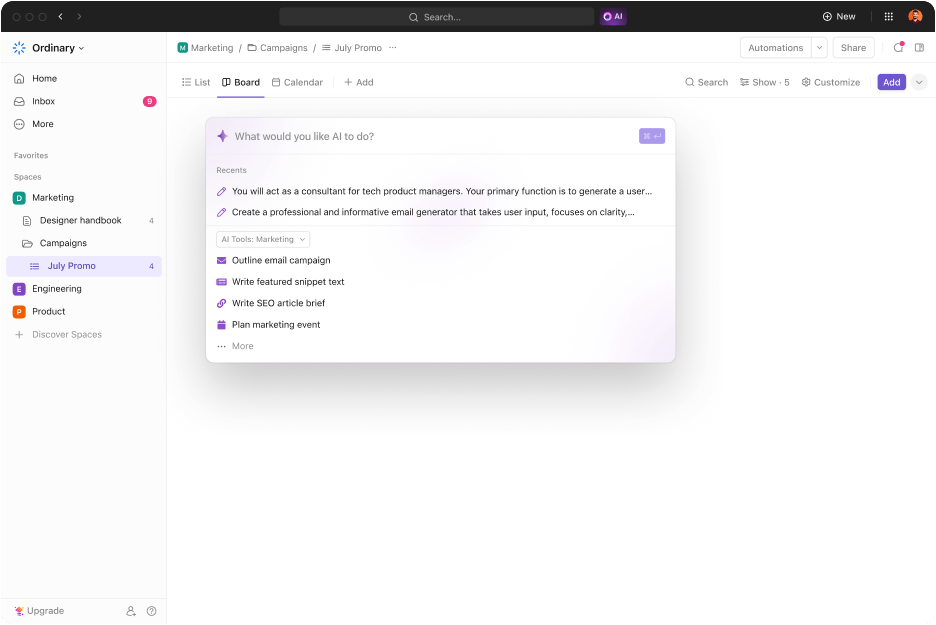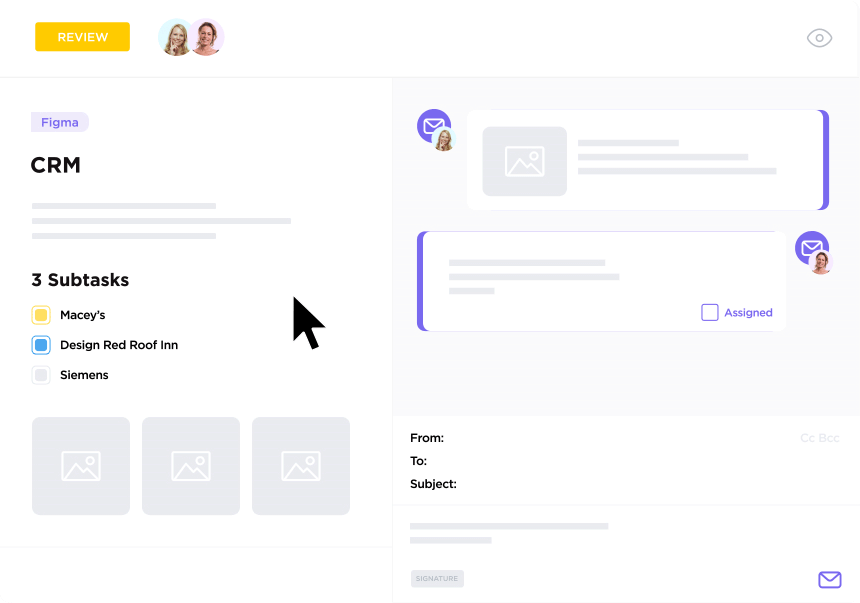في بعض الأحيان، تحتاج إلى القليل من المساعدة في إطلاق حملتك التسويقية أو إطلاق مبادرة ما. وهنا يأتي دور البائعين ووكالات التسويق الرقمي الخارجية. يمكن لهؤلاء الخبراء أن يوفروا لك الوقت والجهد من خلال التعامل مع جوانب معينة من حملاتك التسويقية التي لا يملك فريقك القدرة على القيام بها.
إن أفضل طريقة للتواصل مع هؤلاء الخبراء هي إنشاء طلب تسويق لتقديم العروض (RFP). هذا المستند عبارة عن نموذج طلب بسيط، مما يجعل من السهل توصيل احتياجاتك والحصول على الخدمات الدقيقة المطلوبة للمشروع.
سنقوم هنا بشرح ماهية طلبات تقديم العروض التسويقية، بما في ذلك المكونات الرئيسية التي يجب أن يتضمنها طلبك. كما سنقدم أيضًا دليلًا سهل المتابعة لإنشاء طلب تقديم العروض التسويقية ونصائح لكتابة طلب تقديم عروض تسويقية فعالة، ونصائح للعثور على أفضل الفرص. ✨
## ما هو طلب تقديم العروض التسويقية؟
طلب تقديم العروض التسويقية هو مستند يطلب خدمات لا يستطيع فريقك التعامل معها داخلياً. قد ترسل طلب تقديم العروض لأن فريقك لا يستطيع القيام بمهام إضافية أو قد تحتاج إلى مساعدة من خبير لديه معرفة لا يمتلكها فريقك.
إنه عنصر أساسي في معظم عمليات التخطيط التسويقي ، خاصة للفرق التي تحتاج إلى موارد خارجية لإنجاز المهمة. 📄
يمكنك إرسال طلب عرض تقديم العروض التسويقية إلى وكالة تسويق محددة تهتم بها أو نشره على الإنترنت كنموذج طلب مفتوح للوصول إلى نطاق أوسع. وعادةً ما يستجيب البائعون لطلب تقديم العروض بعرض أسعار عام وخدمات محددة يمكنهم تقديمها وإطار زمني متوقع للتسليمات.
يختلف طلب تقديم العروض عن طلب المعلومات (RFI) أو طلب عروض الأسعار (RFQ). طلب المعلومات هو استبيان أبسط يُستخدم قبل طلب تقديم العروض لتحديد ما إذا كان ينبغي إدراج البائعين في قائمة التواصل. وهو يقوم بشكل أساسي بالتأهيل المسبق للشركات بناءً على الخدمات أو احتياجات الميزانية.
أما طلب عرض الأسعار فهو مستند يطلب معلومات مفصلة عن التكلفة والاقتباس المتعلقة بالخدمة المطلوبة في مستند طلب تقديم العروض. وفي حين أن طلب تقديم العروض يطلب مبلغًا تقديريًا للعرض، فإن طلب تقديم العروض يكون أكثر تفصيلاً، مع تفاصيل تكاليف خدمات محددة بناءً على الجدول الزمني المقدر ونطاق العمل.
فهم طلبات تقديم العروض التسويقية
تعد طلبات تقديم العروض التسويقية موردًا ممتازًا للشركات التي تحتاج إلى مساعدة إضافية في استراتيجية التسويق أو التنفيذ أو التواصل. تتمثل وظيفة طلب تقديم العروض التسويقية في الحصول على مساعدة خارجية. وهذا لا يوفر وقت فريقك فحسب، بل يبني أيضًا علاقات قيمة مع خبراء التسويق. 🤝
يمكن لمشروع التسويق أن يتحرك بشكل أسرع مع طلبات تقديم العروض التسويقية. مع المساعدة الخارجية، يمكنك زيادة عدد الحملات التي تديرها أو تحويل تركيز فريقك الداخلي إلى مشاريع تسويقية أكثر أهمية.
تتضمن بعض فوائد استخدام طلب تقديم العروض التسويقية ما يلي:
- توسيع نطاق وصولك: إرسال طلبات تقديم العروض يجلب الخبراء إليك مباشرةً. وهذا يعني أنه يمكنك إجراء اتصالات وبناء علاقات قيّمة وتوسيع قاعدة معارفك مع إحراز تقدم في المبادرات في الوقت نفسه
- يزيد من الكفاءة: يؤدي طلب تقديم العروض التسويقية إلى إنشاء عملية شراء موحدة للحصول على المساعدة الخارجية في المشاريع. وهذا يقلل من مخاطر سوء التواصل ويبسط عملية اتخاذ القرار، بحيث يمكنك التحرك بشكل أسرع وأكثر كفاءة
- بناء قاعدة بيانات للشركاء والحلول التي أثبتت جدواها: في كل مرة تتواصل فيها مع طلب تقديم العروض، ستحصل على ردود من مختلف المتخصصين في مجال التسويق. يحدد طلب تقديم العروض معايير التقييم حتى تتمكن من بناء قاعدة بيانات للبائعين المحتملين ذوي الخبرة التي يمكنك اللجوء إليها عند إطلاق حملات جديدة
من خلال إرسال طلب تقديم العروض، يمكنك التواصل مع خبراء التسويق الآخرين ونقل المشاريع عبر خط الإنتاج بكفاءة أكبر.
فيما يلي بعض السيناريوهات التي قد ترسل فيها وكالات التسويق طلبات تقديم العروض:
- قد يرسل فريق التسويق الذي يرغب في توسيع مدونته طلب عرض تسويق رقمي إلى وكالة تسويق رقمية أو وكالة محتوى مع متخصصين في تحسين محركات البحث
- قد يرسل قائد فريق التسويق الذي يرغب في إطلاق مشروع إبداعي بمحتوى مرئي احترافي طلب عرض إلى وكالة تسويق رقمية أو وكالة محتوى مع متخصصين في تحسين محركات البحثموجز إبداعي طلب تقديم العروض للعثور على شريك الوكالة المناسب
- يقوم قسم التسويق بمساعدة فريق المنتج على إطلاق ميزة جديدة ويرسل طلب تقديم العروض إلى وكالات الإعلان للحصول على المساعدة في الإعلان عن الإطلاق
- قد تنشئ شركة تسويق واجهت مشكلة في حملة على وسائل التواصل الاجتماعي طلب تقديم عروض للحصول على مساعدة من شركات العلاقات العامة للتعامل مع العاصفة الإعلامية
- شركة تجارية حقيقية تريد إنشاء موقع إلكتروني وبيع المنتجات عبر الإنترنت. يقررون إرسال طلب تقديم العروض إلى خبراء التسويق عبر وسائل التواصل الاجتماعي ومطوري المواقع الإلكترونية لبناء موقعهم الإلكتروني وعلامتهم التجارية ووجودهم على الإنترنت
مكونات طلب تقديم العروض التسويقية
سيكون كل طلب تقديم عروض تسويق مختلفاً ولكن يجب أن يحتوي على مجموعة قياسية من العناصر. ستتغير المعلومات الفعلية التي تقوم بتضمينها أو الخدمات التي تطلبها، ولكنك ستظل بحاجة إلى تضمين التفاصيل الأساسية في كل مستند. ✅
فيما يلي المكونات الأساسية التي يجب تضمينها في طلب تقديم العروض التسويقية:
- معلومات الشركة: قبل أن تطلب من الناس مساعدتك، يجب أن يعرفوا من أنت. قم بتضمين معلومات الشركة الأساسية مثل اسم شركتك ووظيفتها أو مهمتها الرئيسية وأنواع المنتجات أو الخدمات التي تقدمها
- معلومات الاتصال: قم بتضمين رقم الهاتف والبريد الإلكتروني لجهات الاتصال الرئيسية التي تتعامل مع المشروع. في بعض الحالات، قد يكون هذا الشخص هو قائد فريق التسويق. في المبادرات الأكبر، يمكنك تضمين عدة جهات اتصال من عدة أقسام
- لمحة عامة عن المشروع والغرض من طلب تقديم العروض: اذكر بوضوح الغرض من طلب تقديم العروض بما في ذلك أي أهداف لديك والموارد التي تبحث عنها. كلما كنت أكثر إيجازاً هنا، كلما زادت احتمالية حصولك على ردود ذات صلة بطلب تقديم العروض
- معايير التقييم: حدد معايير الاختيار التي ستستخدمها لتقييم المتقدمين. في معظم الحالات، ستتضمن عملية الاختيار أموراً مثل الخبرة في الموضوع أو التسعير أو خدمات محددة
- متطلبات النظر في الطلبات: حدد كيفية تقديم الطلبات (على سبيل المثال، عبر بوابة إلكترونية أو باستخدام نموذج تقديم محدد أو إرسالمقترح عمل إلى البريد الإلكتروني لجهة الاتصال الرئيسية). تأكد من تضمين أي متطلبات محددة للمقترحات التي سيتم النظر فيها
- الجدول الزمني للاختيار: قم بتضمين الجدول الزمني لمشروعك والموعد النهائي المقدر للخدمات التي تطلبها - وبهذه الطريقة لن يتقدم سوى مزودي الخدمة الذين يمكنهم الوفاء بالجدول الزمني الخاص بك
- تفاصيل الميزانية: لا تضيع الوقت في مراجعة العروض التي تتجاوز ميزانيتك. في طلب تقديم العروض التسويقية الخاص بك، اذكر تفاصيل ميزانيتك، ووصف بإيجاز عملية التفاوض في حال اختيار مقدم العرض
إنشاء طلب تقديم العروض لـ خدمات التسويق
سواء كنت ترغب في الحصول على مساعدة في مجال الاتصالات التسويقية أو تسعى للحصول على دعم إعلاني أو تحتاج إلى إطلاق حملات كبيرة بشكل أسرع، استخدم هذا الدليل لإنشاء طلب تقديم العروض. فيما يلي، سنغطي أدناه كل ما تحتاج إلى معرفته لكتابة طلب تقديم عروض تسويق، بما في ذلك إدارة المشاريع التسويقية استراتيجيات لإنجاز المهمة
ابدأ بقالب
اجعل حياتك أسهل باستخدام قالب - مثل قالب قالب طلب تقديم عروض تطوير الويب من ClickUp -لإنشاء إطار طلبك. في حين أن هذا القالب مخصص لفرق التسويق التي تبحث عن مساعدة خارجية لتطوير الويب، يمكنك العثور على قوالب لجميع أنواع طلبات تقديم العروض.

قم بتخطيط عملية تطوير الويب والغرض والهدف والميزانية والجدول الزمني والمزيد في هذا النموذج المفصل
عند اختيار قالب طلب تقديم العروض تأكد من أنه يتضمن المكونات الأساسية لطلب تقديم العروض الجيدة. يجب أن يتضمن الأقسام التي ذكرناها أعلاه، مثل نظرة عامة على المشروع والمعلومات الأساسية عن الشركة.
أضف معلومات مفصلة لكل قسم
بمجرد حصولك على الهيكل العام لوثيقة طلب تقديم العروض، تحتاج إلى ملء جميع التفاصيل ذات الصلة. اعمل من خلال المستند قسمًا تلو الآخر، مع إضافة طلباتك المحددة.

أطلق العنان للإبداع، أو أنشئ قوالب، أو أنشئ نسخة بسرعة البرق مع أفضل شريك للعصف الذهني في العالم
اجعل هذه الخطوة أسهل باستخدام أدوات مثل ClickUp AI لملء المعلومات الأساسية تلقائيًا مثل تفاصيل الاتصال بشركتك ومعلومات الخبرة. قم بإنشاء طلب تقديم العروض الخاص بك في مستندات ClickUp والتي تتيح لك التعاون مع أعضاء الفريق الآخرين لصياغة طلب أكثر فعالية. استخدم ميزة التضمين لتضمين الجداول أو المخططات التي تجعل طلب تقديم العروض أكثر جاذبية.
تحديد البائعين المحتملين وإرسال طلب تقديم العروض
الآن بعد أن أصبح لديك طلب تقديم العروض، ستحتاج إلى إتاحته للبائعين المحتملين. يمكنك نشر طلب تقديم العروض على نطاق واسع من خلال نشر طلب تقديم العروض على موقعك ودعوة أي شخص للتقديم. بدلاً من ذلك، يمكنك الاتصال بوكالات محددة ترغب في العمل معها.
إذا اخترت النهج الأخير، فإن إنشاء قائمة بالبائعين أمر مفيد. مع تسويق ClickUp بما في ذلك إدارة علاقات العملاء (CRM)، يمكنك إنشاء قاعدة بيانات للبائعين. استخدم الحقول المخصصة في ClickUp برنامج إدارة المشاريع التسويقية لتأهيل البائعين المحتملين أو الإشارة إلى استعدادهم للمشاركة إذا كنت قد تواصلت معهم من قبل.

قم بتحسين تنظيم مهامك عن طريق إضافة علامات مخصصة واستخدام خيارات التصفية في عرض القائمة واللوحة لتحديد مهامك ذات الأولوية القصوى بدقة
أثناء إرسالك لطلبات تقديم العروض، قم بتوثيق الردود التي تتلقاها، وأنشئ ملفات تعريفية للبائعين الجدد مع علامات تصنيف للخدمات التي يقدمونها - مثل إنتاج الفيديو أو دراسات الحالة أو خدمات التسويق الرقمي. وبهذه الطريقة، عندما يحين وقت إرسال طلب تقديم عروض جديدة أو طلب خدمات أخرى، يكون لديك بالفعل مجموعة من المرشحين للتواصل معهم.
استخدم الأدوات لإدارة العملية
أفضل طريقة لإدارة العملية هي باستخدام أدوات مثل برنامج إدارة المقترحات ومخططات مثل قالب عملية طلب تقديم العروض من ClickUp . يحافظ هذا القالب على تنظيم فريقك من خلال تتبع تواريخ الاستحقاق المهمة - مثل الموعد النهائي للتقديم - ويجمع الردود في مكان واحد مناسب. 🛠️

استخدم نموذج عملية طلب تقديم العروض لمساعدة الجميع على البقاء على نفس الصفحة عند تقييم عروض الموردين وإدارة عملية تقديم العروض.
أنشئ حقولاً مخصصة لتتبع كل عرض، وأضف علامات الأولوية لتسليط الضوء على عروض محددة تلبي احتياجاتك. تجعل طرق العرض المختلفة - بما في ذلك لوحات كانبان وطرق عرض التقويم ومخططات جانت - تقييم جميع المتقدمين على قدم المساواة وتتبع التقدم المحرز أمرًا سهلاً.

عرض عمليات التشغيل التلقائي النشطة وغير النشطة وإدارتها بسرعة عبر المساحات مع تحديثات المستخدم وأوصافها إدارة المشاريع في ClickUp تعمل الميزات أيضًا على تبسيط سير العمل، وذلك بفضل الأتمتة التي تنقل طلبات تقديم العروض عبر خط سير العمل. أضف مشغلات لتعيين شخص ما في الفريق على الفور لمراجعة الطلب بمجرد إرساله. قم بتعيين أذونات مخصصة لتبسيط عملية اتخاذ القرار وتضمين التبعيات لإنشاء مهام سير العمل التي تُظهر المهام التي تعيق الخطوات التالية في عملية المراجعة.
متابعة
بعد أن تختار أحد البائعين، من الضروري المتابعة وتضمين خطة رسائل واضحة. ستحتاج إلى التواصل مع البائع الذي فاز بالمناقصة والمتقدمين الذين لم يحالفهم الحظ في الاختيار. مثل خطط التسويق واستراتيجياتك، قم بتخصيص استجابتك لفئات مختلفة من المتقدمين.
إذا كنت قد تواصلت مع عدد قليل من مقدمي الخدمات، يمكنك إرسال بريد إلكتروني شخصي إلى كل واحد منهم. أما إذا كنت قد أرسلت شبكة أوسع، فيمكنك تصنيف مقدمي الخدمة على أنهم "غير مؤهلين" أو "مؤهلين ولكن خارج الميزانية" أو "مؤهلين ولكن غير مناسبين" وبناءً على هذه الفئات، يمكنك إرسال ردود مصممة خصيصاً عبر البريد الإلكتروني إلى العديد من المرشحين لتوضيح سبب عدم اختيارهم.

إدارة رسائل البريد الإلكتروني والعمل في مكان واحد-إرسال واستقبال رسائل البريد الإلكتروني في أي مكان في ClickUp، وإنشاء مهام من رسائل البريد الإلكتروني، وإعداد الأتمتة، وإرفاق رسائل البريد الإلكتروني بأي مهمة، والمزيد.
في رسائلك، اذكر بوضوح أن جميع أصحاب المصلحة أعربوا عن تقديرهم للطلب وبيّنوا سبب عدم اختيارهم. اجعل الأمور مهنية ومختصرة، وقم بتضمين صياغة إذا كنت تخطط للتواصل مرة أخرى للمشاريع المستقبلية.
البحث عن طلب تقديم العروض التسويقية فرص العمل
إذا كانت لديك خدمات يمكنك تقديمها لوكالات أخرى، فيمكنك استخدام عدة قنوات للعثور على طلبات تقديم العروض الخاصة بالشركات الأخرى والتقدم إليها حتى تتمكن من تنمية أعمالك الخاصة. 🙌
فيما يلي بعض أفضل القنوات والمنصات للعثور على طلبات تقديم العروض التسويقية:
- وسائل التواصل الاجتماعي : تنشر بعض المؤسسات طلبات تقديم العروض على قنوات التواصل الاجتماعي الخاصة بها - حيث يعتبر موقع LinkedIn الأكثر شيوعًا، على الرغم من أن تويتر يأتي في المرتبة الثانية
- قواعد بيانات طلبات تقديم العروض والإشعارات العامة: يُطلب من الوكالات الحكومية نشر طلبات تقديم العروض الخاصة بها علنًا، والعديد منها يفعل ذلك في بوابات إلكترونية مثلقاعدة بيانات طلبات تقديم العروض. عادةً ما تكون قواعد البيانات هذه قابلة للبحث بحيث يمكنك التصفية حسب المجال أو الخدمات
- البحث على الإنترنت: تنشر بعض الشركات طلبات تقديم العروض على مواقعها الإلكترونية الخاصة أو في المواقع الإخبارية وقواعد البيانات. يمكنك العثور عليها باستخدام محركات البحث وكتابة الصناعة أو الخدمات وكلمات "طلب تقديم العروض" للعثور على النتائج ذات الصلة
نصائح لكتابة رد رائع على طلب تقديم العروض التسويقية
أنت تعرف كيف تكتب طلب تقديم عروض تسويقية تطلب خدمات من البائعين، ولكن ماذا لو كنت تريد التقدم بطلب تقديم عروض تسويقية بعروضك الخاصة؟ سنقدم هنا أهم النصائح وأفضل الممارسات عند صياغة رد على طلب تقديم عروض تسويقية. ✍️
إذا كنت ترغب في الحصول على عملاء بنجاح من خلال التقدم إلى طلب تقديم العروض، فأنت بحاجة إلى القيام ببعض الأعمال القانونية. قبل التقديم، قم بإجراء بحث عن الشركة. من خلال معرفة ما الذي يدفع الشركة، يمكنك تكييف طلبك مع ما يريدونه بالضبط. اعرف ما إذا كانوا قد أرسلوا طلبات تقديم العروض من قبل ومن فاز بالمناقصة بنجاح. بعد ذلك، حاول تحديد ما فعلوه بشكل صحيح وقم بتكرار ذلك.
من الضروري أيضاً التأكد من أنك مؤهل. فأنت لا تريد أن تضيع وقتك في التقدم للوظائف الشاغرة إذا كنت لا تستطيع تلبية المتطلبات. اقرأ التعليمات بعناية واتبع جميع التعليمات إذا قمت بالتقديم، واطرح الأسئلة إذا كنت بحاجة إلى توضيح.

يتيح مستندات ClickUp Docs التنسيق المنسق وأوامر الشرطة المائلة للعمل بكفاءة أكبر
فيما يلي بعض الأمثلة على استجابات طلبات تقديم العروض الناجحة:
- الإجابة بالنواتج: "فريق المحتوى لدينا مرن. نحن ننشئ محتوى بشرياً - وليس محتوى ذكاء اصطناعي عادي - للتواصل مع القراء، وبناء جمهورك، وتطوير علامتك التجارية."
- إظهار خبرتك: "نستخدم نهجاً متعاطفاً لتلبية احتياجاتك في مجال العلاقات العامة. في المشاريع السابقة، أنشأ فريق الأمن لدينا تقارير الحوادث والمقالات الإخبارية لشرح الخطأ الذي حدث، وكيف خططنا لإصلاحه، وما يمكن أن يتوقعه العملاء. وفي الوقت الذي أكدنا فيه للعملاء أن مصالحهم الفضلى قد تمت معالجتها، قمنا أيضًا بترسيخ مكانة العميل كقائد يمكن الوثوق به."
- دع العملاء يقومون بالعمل نيابةً عنك من خلال شهادة: "كيف يمكننا مساعدتك؟ سنسمح لعملائنا بإظهار مدى القيمة التي نقدمها ولماذا فزنا بالعشرات من طلبات تقديم العروض في الماضي: "لقد حقق فريق العلامة التجارية [الشركة] نطاق مشروعنا، وجاء في حدود الميزانية، وأنجز كل ذلك في وقت قياسي. وبفضل قنوات الاتصال الواضحة، كنا نعرف دائماً أين وصل المشروع وما هو قادم - دون أي مفاجآت."
إن صياغة الرد على طلب تقديم العروض لا يقتصر فقط على تضمين المعلومات ذات الصلة. فمن المهم أيضاً ترك بعض الأشياء خارجاً.
إليك ما لا يجب عليك تضمينه في طلب تقديم العروض:
- التسعير الأسعار المنخفضة للغاية: قد يكون التسعير المنخفض للغاية غير مناسب، وستتساءل الشركات عن سبب كون خدماتك أرخص بكثير - وقد تعتقد أن السبب في ذلك هو أنك تقدم قيمة أقل. بدلاً من ذلك، استخدم التسعير على أساس القيمة لإنشاء عرض أسعار عادل يعكس خبرتك ويجعل الأمر يستحق وقتك
- نسخ ولصق الإجابات: يجب أن تكون كل إجابة من إجابات طلب تقديم العروض مصممة خصيصاً للعرض المحدد. الإجابات المنسوخة تعني أنه من غير المرجح أن تحصل على العرض، ويمكن أن تتسبب في حدوث ارتباك إذا قمت بنسخ معلومات غير ذات صلة
- الكثير من المصطلحات التقنية: إذا كانت الشركة ترسل طلب تقديم العروض، فقد يحتاجون إلى المساعدة من حيث المعرفة في مجال الموضوع. إذا كان عرضك تقنيًا أكثر من اللازم، فقد لا يفهمون القيمة التي تقدمها أو قد يشعرون أنها غير مناسبة
الأسئلة الشائعة
هل ما زلت تريد معرفة المزيد؟ إليك الأسئلة الأكثر شيوعاً حول طلبات تقديم العروض.
1. ما هو طلب تقديم العروض للتسويق والعلامة التجارية؟
هذا النوع من طلبات تقديم العروض هو عرض ترسله الشركة إلى البائعين الذين يقدمون خدمات التسويق والعلامات التجارية.
2. كيف يمكنني العثور على طلبات تقديم العروض التسويقية؟
إذا كنت ترغب في التقدم لطلبات تقديم العروض التسويقية، ابحث في مواقع مثل LinkedIn وTwitter والبوابات التي تنشر فيها الوكالات الحكومية والشركات العامة طلبات تقديم العروض.
3. هل طلب تقديم العروض معلومات عامة؟
لا يتوجب على القطاع الخاص نشر طلبات تقديم العروض على الملأ. ومع ذلك، يتعين على الوكالات الحكومية والشركات في القطاع العام إدراج طلبات تقديم العروض كمعلومات عامة.
أفكار ختامية حول طلبات تقديم العروض للتسويق والإعلان
تعد طلبات تقديم العروض في مجال التسويق والإعلان أدوات أساسية للحصول على خبرات خارجية لاستكمال مشاريعك الحالية. إنها فرصة لبناء حملات أفضل وتقديم خدمات محسنة لعملائك، دون الحاجة إلى أخذ الوقت من مجالات التركيز الداخلية الأخرى.
لإنشاء طلب تقديم عروض تسويق رائع، من المهم تضمين الأقسام الرئيسية، والاستفادة من أدوات مثل الذكاء الاصطناعي لتبسيط العملية، واستخدام برنامج لتتبع الردود وتخزين التحليلات لحملاتك. اشترك في ClickUp اليوم لبدء إنشاء طلبات تقديم عروض تسويق أفضل. بفضل أدوات وقوالب الذكاء الاصطناعي المدمجة، يمكنك إنشاء مسودات ومخططات لطلبات تقديم العروض في ثوانٍ معدودة. وبالإضافة إلى ميزات إدارة المشروع والعروض المتعددة، من السهل إدارة عملية طلب تقديم العروض من البداية إلى النهاية. 💪

